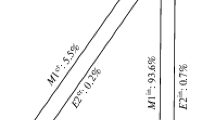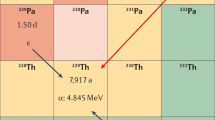The use of the nuclide 229Th as a new nuclear-optical frequency standard is studied theoretically. The mechanism for two-photon optical pumping of the 7.6 eV isomer through the optical shell in singly charged ions is examined. The decisive role of the 8s–7s resonance transition is demonstrated. It is shown that the required energy of the two photons is equal to the sum of the energies of the nuclear level and the 7s-state of the atom. The lifetime of the isomer in the singly charged ion is 165 sec.


Similar content being viewed by others
References
B. R. Beck, J. A. Becker, P. Beiersdorfer, et al., “Energy splitting of the ground-state doublet in the nucleus 229Th,” Phys. Rev. Lett., 98, 142501-1–142501-4 (2007).
F. F. Karpeshin and M. B. Trzhaskovskaya, “Resonance conversion as the main channel for decay of the 3.5 eV isomer in 229mTh,” Yad. Fizika, 69, 596–604 (2006).
F. F. Karpeshin and M. B. Trzhaskovskaya, “Impact of the electron environment on the lifetime of the 229Thm low-lying isomer,” Phys. Rev. C, 76, 054313-1–54313-10 (2007).
C. J. Campbell, A. G. Radnaev, A. Kuzmich, et al., “Single-ion nuclear clock for metrology at the 19th decimal place,” Phys. Rev. Lett., 108, 120802-1–120802-5 (2012).
N. Huntemann, C. Sanner, B. Lipphardt, et al., “Single-ion atomic clock with 3·10–18 systematic uncertainty,” Phys. Rev. Lett., 116, 063001-1–063001-5 (2016).
L. Wense, B. Seiferle, M. Laatiaoui, et al., “Direct detection of the thorium-229 isomer: Milestone towards a nuclear clock,” Nature, 533, 47–63 (2016).
F. F. Karpeshin, I. M. Band, M. B. Trzhaskovskaya, and M. A. Listengarten, “Optical pumping 229mTh through NEET as a new effective way of producing nuclear isomers,” Phys. Lett. B, 372, 1–7 (1996).
F. F. Karpeshin, Nuclear Fission in Muonic Atoms and Resonance Conversion, Nauka, St. Petersburg (2006).
9. T. T. Inamura and H. Haba, “Search for a ‘3.5-eV isomer’ in 229Th in a hollow-cathode electric discharge,” Phys. Rev. C, 79, 034313-1–034313-10 (2009).
O. A. Herrera-Sancho, N. Nemitz, M. V. Okhapkin, and E. Peik, “Energy levels of Th+ between 7.3 and 8.3 eV,” Phys. Rev. A, 88, 012512-1–012512-7 (2013).
L. F. Vitushkin and A. I. Mikhailov, “Two-photon ionization of atoms by photons from different beams,” Opt. Spektrosk., 50, 11–18 (1981).
B. A. Zon and F. F. Karpeshin, “Accelerated decay of the 235mU nucleus by resonance internal conversion stimulated by laser radiation,” Zh. Eksp. Teor. Fiz., 97, 401–408 (1990).
NIST Atomic Spectra Database, www.nist.gov/pml/data/asd.cfm, acces. Jan. 1, 2016.
I. M. Band, M. B. Trzhaskovskaya, C. W. Nestor Jr., et al., “Dirac–Fock internal conversion coefficients,” At. Data Nucl. Data Tables, 81, 1–334 (2002).
Author information
Authors and Affiliations
Corresponding author
Additional information
Translated from Izmeritel’naya Tekhnika, No. 7, pp. 29–32, July, 2016.
Rights and permissions
About this article
Cite this article
Karpeshin, F.F., Trzhaskovskaya, M.B. The 229Th Isomer Line as a Reference for a High-Precision Frequency Standard. Meas Tech 59, 722–727 (2016). https://doi.org/10.1007/s11018-016-1036-8
Received:
Published:
Issue Date:
DOI: https://doi.org/10.1007/s11018-016-1036-8




